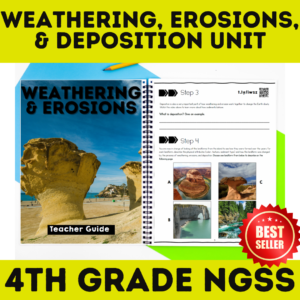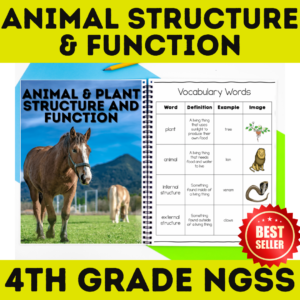Description
Are you looking for an engaging 4th Grade NGSS Renewable Energy unit curriculum? This unit is an easy PRINT-AND-GO download. In the PDF you will have the teacher guide as well as the student journals. The lessons are clearly explained, and your students will love learning about renewable energy with the hands-on, engaging activities.
What’s included in this Renewable Energy Unit?
- Easy, Print-and-Go PDF that includes a TEACHER GUIDE and STUDENT JOURNAL (Bonus File)
What can you find in the teacher guide?
- Hyperlinked Table of Contents
- Scope and Sequence
- Video Lectures for Every Lesson (Youtube)
- Lesson Slides (Google Slides and Editable)
- Lesson Check for Understanding (Google Form)
- Lesson plans
- Quick Digital Links to all Assessments
- Materials List
- Tips for Teaching
- Examples of Student Outcomes
- Posters and Vocabulary Journal
- Task Cards
- Flipbooks
- Answer Key
What’s in the student journal?
- All the pages the students will need to complete the unit
- Lesson Notes Pages
- Reading Passages and Comprehension
- Engaging Lesson Activities (Webquests, Centers, Stem Challenge)
- Vocabulary Pages
- End of Unit Assessment
- Early Finisher Work (Word Searches, Coloring Pages, Extension Writing Activities, Create-a-Comic, Information Flags)
What are students learning?
This unit is broken down into 4 parts. Each part includes a lesson plan of activities. The following is the breakdown of the unit:
- Part 1 – Renewable and Nonrenewable Energy: Students will get an introduction to renewable and nonrenewable energy by going through the guided lesson, reading about biomass and renewable energy, and completing a hands-on lab that helps students see how much energy they truly use at home.
- Part 2 – Renewable Energy Benefits & Drawbacks: Students will learn more in-depth about renewable energy. After the guided lesson, the students will then complete a jigsaw activity of 5 reading passages (Tidal, Solar, Geothermal, Hydropower, Wind Energy). They will then be independently learning about renewable energy with a WebQuest.
- Part 3 – Reduce, Reuse, Recycle, & Upcycle: Students will be more focused on how humans can help with the environment in this part. They will learn with the guided lesson and then complete a jigsaw activity of 4 reading passages of Air, Land, and Water Pollution. Students will then show their learning with a renewable energy flipbook. This flipbook can be displayed on bulletin boards. The students can review the concepts with task card games.
- Part 6 – Upcycle Item Stem Challenge: Students will take everything they have learned about renewable energy and apply them in this cumulative project. This project is an Upcycle Item STEM Challenge. Students will go through the engineering design process as they work through the problem of creating a gift from everyday items.
Who can use this resource?
- 4th Grade Elementary Teachers
- 5th Grade Elementary Teachers
- Homeschool Science Curriculum for 4th-5th Grade
- Learning Pods Curriculum for 4th-5th Grade
What are teachers saying about the resources in this bundle?
⭐⭐⭐⭐⭐“Great resource for end of the year project. My students enjoyed presenting their research!”
⭐⭐⭐⭐⭐“This is a great resource! I used it as a whole group with my 4th grade students before my lesson and again after my lesson. This was easy to assign and set up. The directions were clear and understandable which in turn kept my students engaged and on task. I was also able to use this with the on-line portion of my students as well. I highly recommend this resource! I will most definitely be looking for other resources that have been created by this author.”
⭐⭐⭐⭐⭐“I left this for a sub and it was a HUGE hit! The kids loved it from start to finish! Thank you for making science so relevant to their lives! :)”
⭐⭐⭐⭐⭐“Engaging activity in breakout rooms during distance learning! I know I will use it when we return to the classroom as well :)”
⭐⭐⭐⭐⭐“During this difficult school year it has been such a relief to find lessons like this that I can break up into smaller segments to remind students about what we have been learning. Since half of them are not in the room with me it is difficult to review and keep things fresh when I am not always with them. This was the perfect compliment to our unit on Food Webs and Human resources. Thank you so much for making it clear and letting students read through and be able to answer simple questions to show they understand. ”
NGSS Standards Alignment
4-ESS3-1 Obtain and combine information to describe that energy and fuels are derived from natural resources and their uses affect the environment.
4-ESS3-2. Generate and compare multiple solutions to reduce the impacts of natural Earth processes on humans







Reviews
There are no reviews yet.